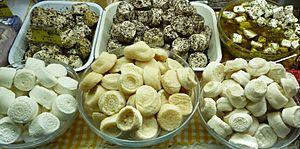Ġbejna facts for kids
Ġbejna (Maltese pronunciation: [dʒbɛɪ̯na], plural ġbejniet) is the diminutive of the Maltese word ġobna, which means "cheese"; it is synonymous with the Maltese English word "cheeselet", i.e. "little cheese". The rest of the article describes 'Ġbejna tan-nagħaġ', a type of Maltese cheeselet made in Malta and Gozo.
Ġbejna tan-nagħaġ is a small round cheese made in Malta from sheep milk, salt and rennet. Most sheep's milk produced in Malta is used for the production of these small cheeses.
Milk in Malta was traditionally sold by milking goats on the streets and sold immediately as is. The unpasteurised milk sold was one of the causes of the spread of brucellosis (Maltese: Deni Irqiq; "The Maltese Fever") in the late 19th to the early 20th century. Themistocles Zammit is credited with stopping the pandemic.
Prior to Malta's accession to the European Union, the EU accepted Malta's request to protect the ġbejna along with the traditional variant of ricotta.
Preparation and varieties
Ġbejna is shaped in a cheese hurdle made of dried reeds, although now plastic ones are also used. They are traditionally dried in small ventilated rooms, with windows protected by a special mesh mosquito net. It is said that in the past sea water, rather than rennet, was used as a curdling agent. The cheese is available both from pasteurised and unpasteurised milk.
Ġbejniet are prepared and served in a variety of forms: fresh (friski or tal-ilma), sundried (moxxa, bajda or t'Għawdex), salt cured (maħsula), or peppered (tal-bżar). The fresh variety have a smooth texture and a milky flavour and are kept in their own whey in a similar manner to mozzarella. The sundried variety have a more definite, nutty almost musky taste, and are fairly hard. The peppered variety are covered in crushed black pepper and cured, after which they may be stored in oil or pickled in vinegar. Their sharp taste becomes more piquant the more they age, and they also develop a crumbly texture.
In Maltese cuisine
Ġbejna is an important element in a number of dishes such as soppa tal-armla. It is often added to pasta dishes or soup to enhance flavour, as a pizza topping or the filling for ħobż biż-żejt.
Gbejniet are sold in fresh, dried, or cured forms and may be seasoned with pepper or other herbs. You may find it deep-fried as an appetizer, cured on a mezze platter or even fresh as a filling for pasta. It is found on restaurant menus, or at a Maltese grocery or supermarket.
See also
 In Spanish: Ġbejna para niños
In Spanish: Ġbejna para niños


